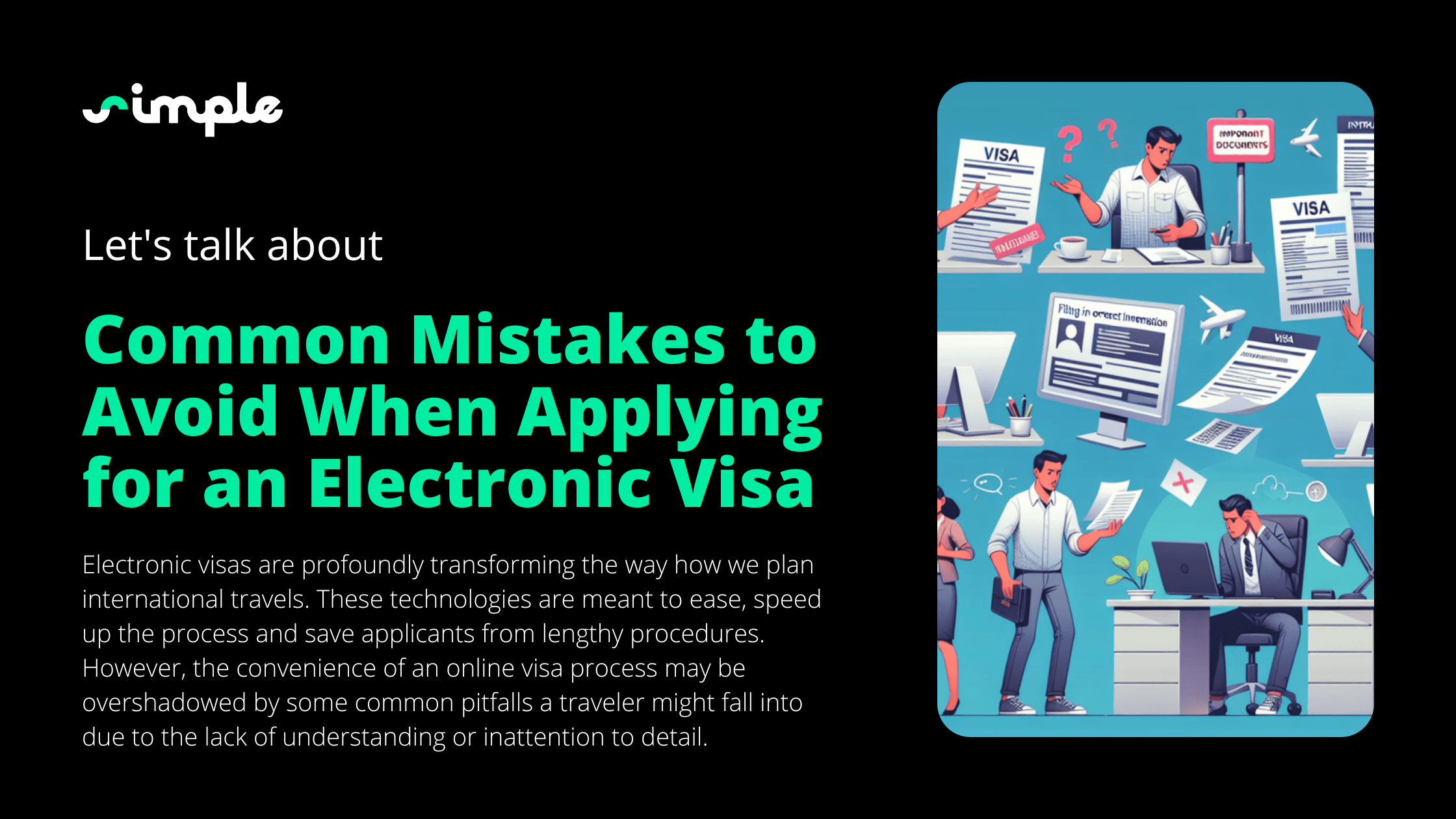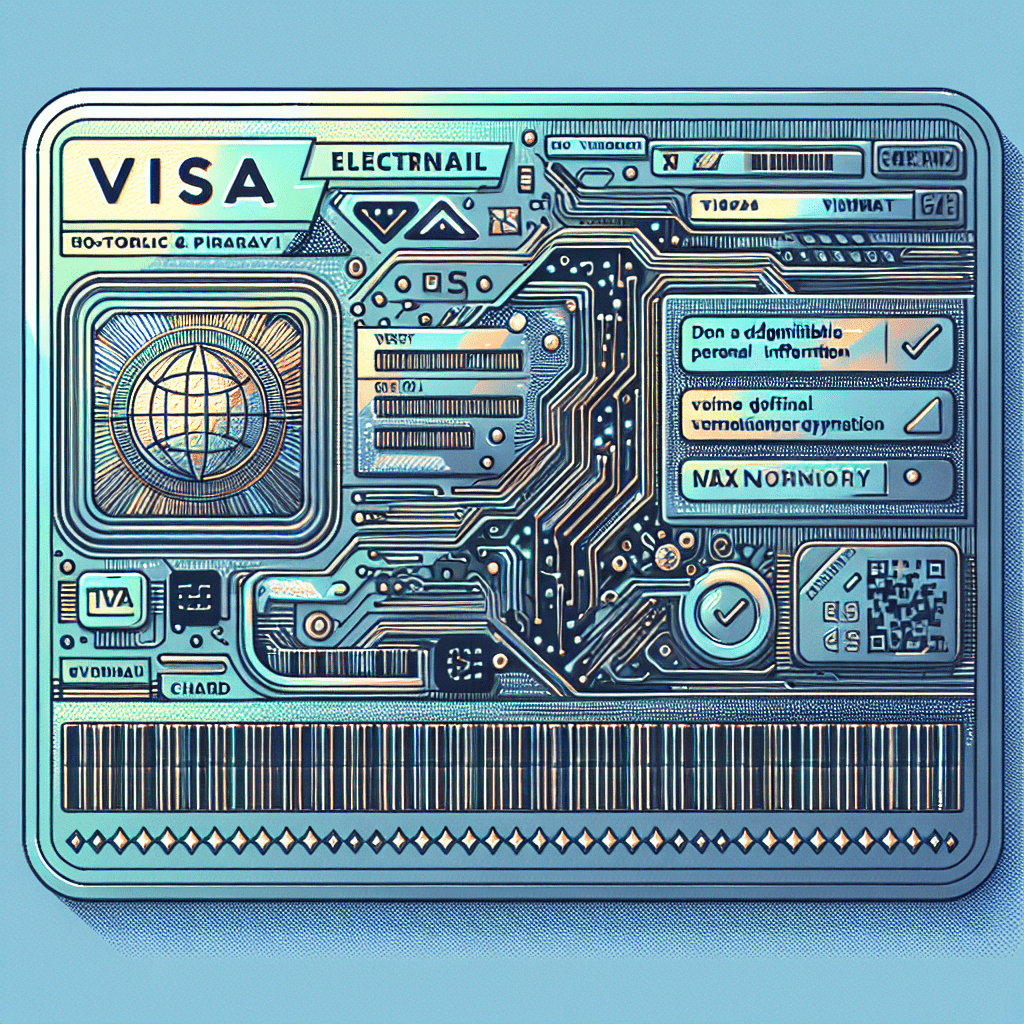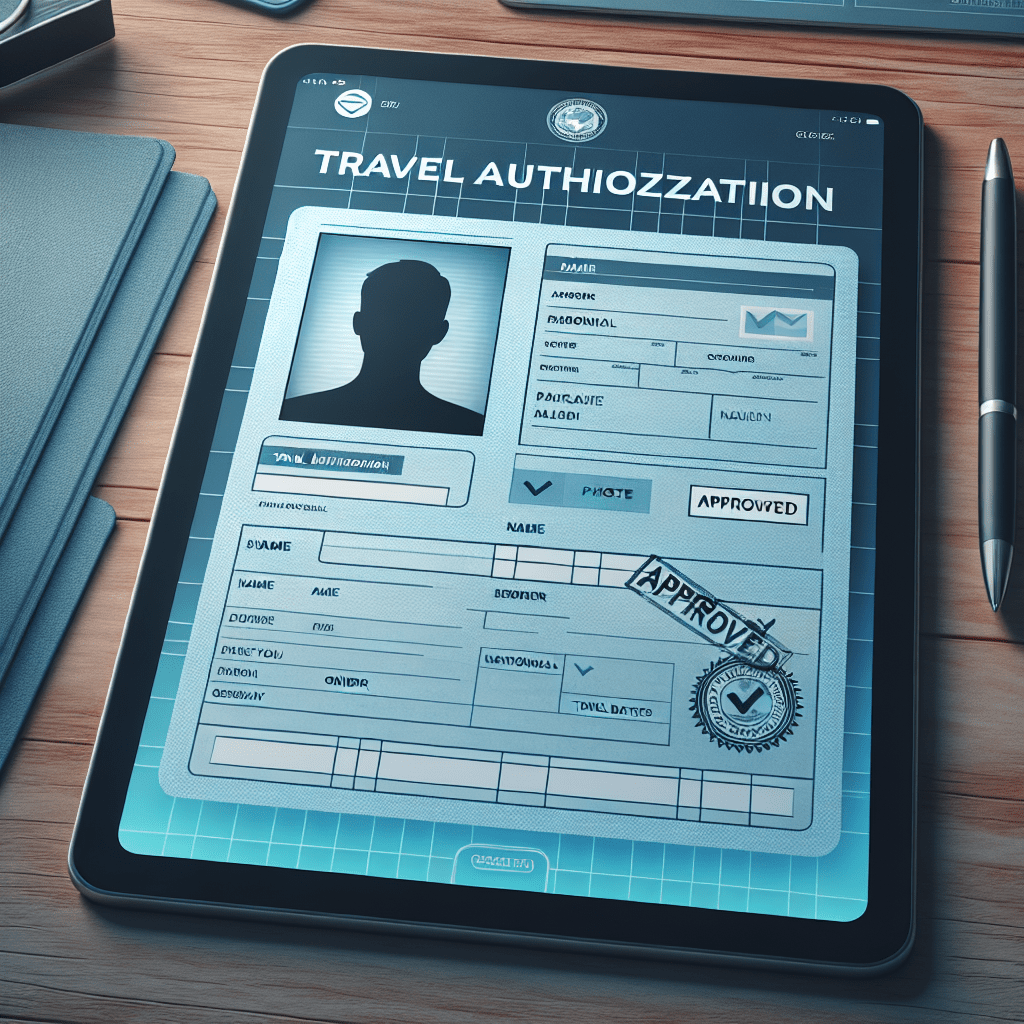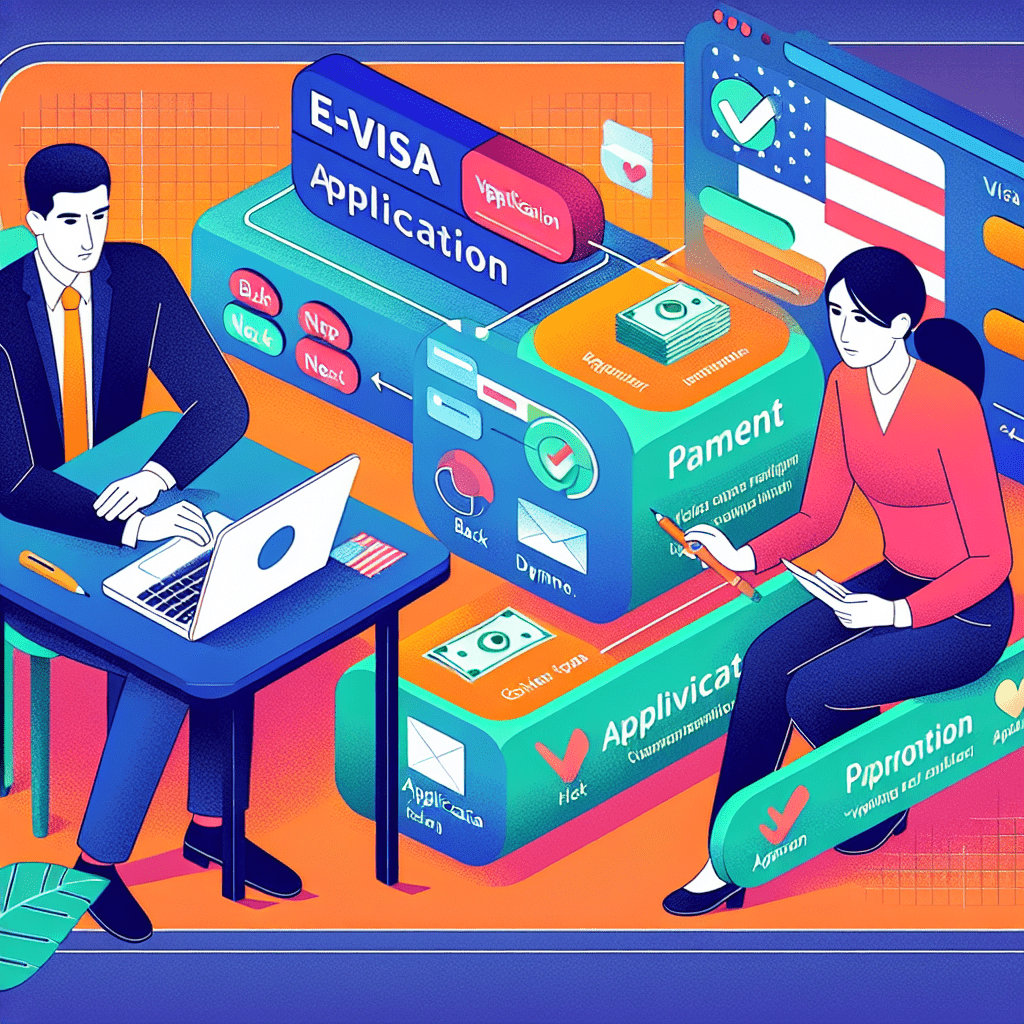Electronic Visa : Common Mistakes to Avoid When Applying

Electronic visas are profoundly transforming the way how we plan international travels. These technologies are meant to ease, speed up the process and save applicants from lengthy procedures. However, the convenience of an online visa process may be overshadowed by some common pitfalls a traveler might fall into due to the lack of understanding or inattention to detail.
This piece is aimed at those who plan to use an electronic visa for their upcoming travel. It provides a brief overview of e-visa and underlines the significance of correct application practices. Knowledge about this will alert you to common errors during the e-visa application process, helping to ensure that your electronic immigration document’s approval isn’t delayed or denied.
Beyond convenience, adherence to correct application practices is vital to securing your digital tourist visa. After all, the stakes are high, and even trivial mistakes in your e-visa application can cause substantial disruptions in your travel plans.

Incomplete or Incorrect Information
Navigating the electronic visa application process is relatively straightforward. Yet a considerable number of applications are hampered, not due to the complexity of the digital tourist visa process, but unfilled or wrongly filled data entries.
The repercussions of supplying insufficient data
An incalculable number of delays in e-visa approvals result from partial submissions. In simple terms, the accuracy and completeness of your internet visa application determine the outcome and turnaround time of your digital travel authorization request. Leaving mandatory fields blank or providing inadequate responses can result in processing delays, as additional time is required to contact the applicant or gather missing data. The worst-case scenario is glaring: potential dismissal of the application.
The importance of verifying details before submission
The requirement for meticulousness cannot be overstressed when it comes to e-visa application. Every tidbit of personal information and passport info provided must be precise. The data you supply in the application must correlate with what’s on your official documents. For instance, if the names on your passport and electronic immigration document application are inconsistent, your online visa process might come to a grinding halt.
Even minor errors, such as a slip in your birth date or misplacement of letters in your name or passport number, can lead to your e-visa application being denied. The onus lies on the applicant to triple-check all the entered information before hitting the ‘Submit’ button on the electronic visa submission panel.
Misunderstanding the Note of Purpose/Reason for Travel
A common pitfall involves misunderstandings or misinterpretations of the ‘Purpose of Visit’ or ‘Reason for Travel’. These mishaps could be avoided by fully understanding the visa categories and meticulously selecting the one that aligns with your intent.
The consequences of not clarifying or wrongly stating your purpose of visit can range from unnecessary questioning at the port of entry to a straight-up refusal of your electronic entry permit. For instance, obtaining a tourist visa when your actual intention is to engage in business-related activities could be perceived as a ruse to bypass the proper online visa process, which could land you in trouble.
The types of electronic visa issued differ from country to country, each catering to specific purposes – be it tourism, business, study, transit, or freelance work. Hence, it is incumbent on the applicant to clarify the intent of travel, choose the suitable visa type, and align their application, supporting documents, and activities in the visiting country accordingly.

Failing to Prepare Necessary Documents
When it comes to the electronic visa process, one can liken it to a potent game. Your online visa checker is the goal, and the preparation and submission of necessary documents are your maneuvers to score your ‘goal,’ i.e., your electronic visa approval. However, some applicants end up on the losing side due to underestimating the gravity of this crucial task.
Misunderstanding the required documents
The fate of an electronic visa application lies not only in the information provided but also on the authenticity of the supporting documents. Misinterpretation or overlooking the paperwork needed for a digital travel authorization can have severe implications. It could lead to the outright rejection of the application.
The specific documents required and their format of submission vary based on the type and destination of the travel. Generally, it includes but is not limited to personal identification documents, address proofs, passport copies, financial stability proofs, flight and accommodation details, etc. An underscoring necessity is the early preparation of these documents to allow ample time for any potential corrections or more documentation if needed.
Forgetting to upload supporting documents
One might assume that the internet-based travel authorization essentially eliminates the need for physical documentation. On the contrary, this digital platform demands the same, albeit in soft copy formats. There have been instances where applicants, blinded by the lure of a hassle-free virtual visa service, forget to upload necessary digital copies of their supporting documents.
Such negligence can stall the online visa process, for these documents are imperative for the verification of the applicant’s declarations. Adherence to the specified file formats is also mandatory. More often than not, e-visa application platforms specify the requisite file formats and sizes for each document. Overlooking this detail might place an unnecessary roadblock in your web-based visa application path.
Neglecting to review guidelines about passport photos
Another common mistake is the disregard for photo specifications. Like the conventional visa application, the electronic travel permit process demands passport photographs adhering to exact specifications. A photo is a prominent component of the e-visa application, and non-conforming photographs could delay or even jeopardize e-visa approval.
Guidelines around size, quality, background, proportion of face, glasses, attire, and digital format of photo should be religiously adhered to. An oversight in these parameters could invite unnecessary queries or even a refusal of the electronic entry permit.
In conclusion, to avoid costly errors during the e-visa application process, one would do well to thoroughly understand the specific guidelines for required documents, upload all requisite digital copies in the prescribed format, and strictly adhere to the photo guidelines laid out by the respective immigration authorities.

Neglecting to Follow up on Your Application
The e-visa application process may seem like a one-time task – you fill out the application, pay the fees, and wait for approval. However, experienced travelers and immigration professionals will attest that it involves consistent tracking and proper follow-up. Falling short on these aspects can become a major setback in securing your electronic entry permit.
Implications of not keeping track of application status
The rather simplified mechanism of the online visa process might often give applicants a false sense of security. Complacency and disregard for continuous monitoring can have profound implications on your digital travel authorization. Staying informed about your internet visa application status allows timely interventions in cases of discrepancies or disputes.
While auto-reminders and update emails are usually part of any virtual visa service, proactive review of the electronic visa submission status is the surest way to stay ahead of any potential issues. Waiting until the last-minute to check on your application is hazardous, for it leaves no scope for resolution if there’s any issue pending.
Not scheduling time for potential setbacks
Every seasoned traveler knows that even the most meticulously planned trips have unexpected obstacles. This principle applies to your electronic immigration document application as well. Delays in e-visa application processing can arise from the simplest reasons – a sudden surge in applications, restrained manpower, technical glitches, or holiday periods.
Building a buffer for such unforeseen occurrences is prudent. Submitting your e-visa application well ahead of your travel date will provide ample time to deal with any prospective complications. As the saying goes, ‘Hope for the best, but prepare for the worst’. This practice ensures that you are not caught off guard and left scrambling at the eleventh hour.
Overseeing payment details and confirmation
Another critical area that applicants often overlook is the payment phase. With many e-visa applications, a successful payment transaction does not necessarily mean the successful submission of your application. There could be glitches, and payments could get stuck or not get linked correctly with your application.
Ensuring successful payment transaction and verifying the same on the application platform is imperative to avoid unnecessary interruptions in the online visa process. Further, retention of payment and confirmation receipts is vital. These documents serve as proof of the transaction and can be handy in case of disputes or while seeking a refund in case your application is not approved. They also prove useful while checking your e-visa status update.
In sum, keeping track of your application status, preparing for potential setbacks, and prudently overseeing your financial transactions are critical steps that are as essential to your e-visa application process as filling out the application diligently. These steps ensure a smooth journey from submission to approval.

Streamlining Your Electronic Visa Application Process
Securing an electronic visa provides a sense of relief, knowing that one of the major travel preparations has been successfully checked off the list. The advantage of speed, convenience, and simplicity, while applying for an e-visa, shouldn’t lead one to overlook the meticulousness required in making a successful application.
The key lies in being thorough right from the start. Fill the application accurately, submitting all the necessary documents in the right format, and taking care of all details – no matter how insignificant they appear. An essential element here is a deep understanding of how the e-visa system works. To ensure a successful application, being proactive, diligent, and maintaining a status check on the web-based visa application is important.
Remember, every careful step you take in the process of securing your electronic travel permit saves you time, money, and stress, and paves the way for a smooth journey. It also eliminates any chances of being stranded or facing unpleasant encounters at the port of entry.
Into the future, the landscape of international travel will see electronic visas playing an increasingly crucial role. The journey to secure an e-visa is not a one-time endeavor but an ongoing learning process that gets streamlined with every new application. Armed with the knowledge gleaned from previous experiences and usage of comprehensive online visa checker services, travelers can navigate this landscape with increased ease and confidence.
The world of e-visas continues to evolve. Yet, the principles and practices that underline a successful application remain steadfast. The beautiful, enriching journey to your dream destination begins with a carefully, correctly filled electronic visa application.